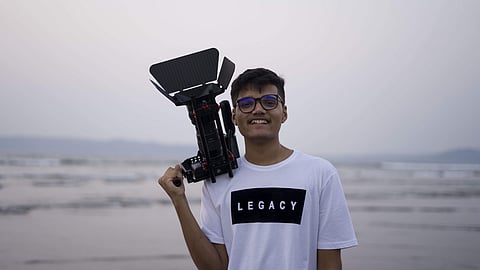

For some people, the realisation that the 'personal' and the 'political' intersect changes their entire worldview. It may even put them on a road that helps them achieve something extraordinary. Similar is the story of this 18-year-old documentary maker from Goa, Kabir Naik, whose film The E-learning Gap on the rural-urban digital divide, which was released on YouTube this July, has been doing the rounds amongst locals and a small pocket of intellectuals. "I have a friend from Valpoi, one of the remote villages in Goa. Over a phone call, he told me how difficult he was finding it to study," Kabir recalls. That got his gears turning. If someone whose parents are educated is having a hard time studying, what about others in the hinterlands of Goa? That is when he took a journey across the six remotest villages of Goa to see the reality for himself.
The documentary, which was shot in the month of June, starts with a voiceover where Kabir raises an important question: How prepared is our education system to handle another academic year online? From here, the film takes the viewer through the villages in Goa's Sattari taluka where a significant number of students are first-generation learners. "Three amongst the six villages I visited are in the most extreme points of Goa. The 'endpoints', if you may. But they also have a huge population which is usually ignored by mainstream media," Kabir says. Another two villages were central lands where rains create havoc during the monsoons and the internet connectivity is a game of luck. One of the six villages was a much more accessible one, this was chosen to see if that accessibility, in terms of close proximity to the urban areas, makes a difference in children's learning.
One can see parents from the hinterlands of Goa amidst heavy rains, haunted and frightened by the reality that their children have been deprived of education because they don't live in the cities. And then there are the children, a lot of children, so many that one loses count while watching the documentary. While some find it difficult to cope with Math and Science, others say that learning English becomes a problem. Most of them complain that their teachers fail to acknowledge their very real problems and believe that the children are just making excuses by citing network issues. There are also expert voices in the documentary who suggest that small SD cards can perhaps work as an alternative to online learning. This can be a combination of audio and video lectures. But Kabir still finds it as a temporary Band-aid because Math and Science would still pose a challenge even after that.
What stands out
There is a striking scene in the documentary that perhaps captures what Kabir set out to find — as villagers get internet only on the adjoining main roads, they set up tall structures with bamboo for their children to sit in and study, even if it rains. "It is the struggle of the people that shook me. Even after all this, the people there wonder if it is worth it," he says. When asked about his process to approach people, he says, "Most of my documentary topics are in the rural areas. I put out a request on my social media to connect me with someone who lives in these villages. That usually works. Goa is a very small place where everybody is well connected if they're a local," Kabir says. That one person tells the locals a few days prior to the shoot that somebody would be coming to speak with them so that they grow comfortable with the idea of being in front of a camera.
"I couldn't shoot anything on 4K cameras because it was raining constantly. All outdoor shots were on a GoPro camera. There was no boom mic either, just a collar mic," Kabir says. But he is quick to add that lack of big equipment worked in his favour as "such things can often be intimidating to someone who is not used to being in front of the camera." But people were at ease, he says. This is not the only documentary that Kabir has made, he is usually accompanied by a team but this particular film was an exception. "It was just me and my friend's father. He helped me get around the different villages," Kabir says. This was almost like a personal endeavour for Kabir, it is perhaps for this reason that he doesn't want to monetise on this documentary. "People in these villages helped me out, fed me and arranged for our accommodation. I didn't have to pay for anything. It feels morally wrong to try and monetise on this documentary." However, he does have a source of revenue where he makes advertisements for various private companies.
The big impact
In the entire course of the film, parents and children are seen complaining that teachers don't accept that there are genuine connectivity issues. Just a few days after Kabir's documentary was released, it became the talk of the town. "Within a week after my documentary was released, the teachers were seen actually visiting three villages that were completely disconnected, to check on the children. Even though I can't definitively say that it was because of my documentary, it seems like it was," Kabir says. There is also a private internet company that has recently reached out to Kabir to provide free internet to the students for a year.
